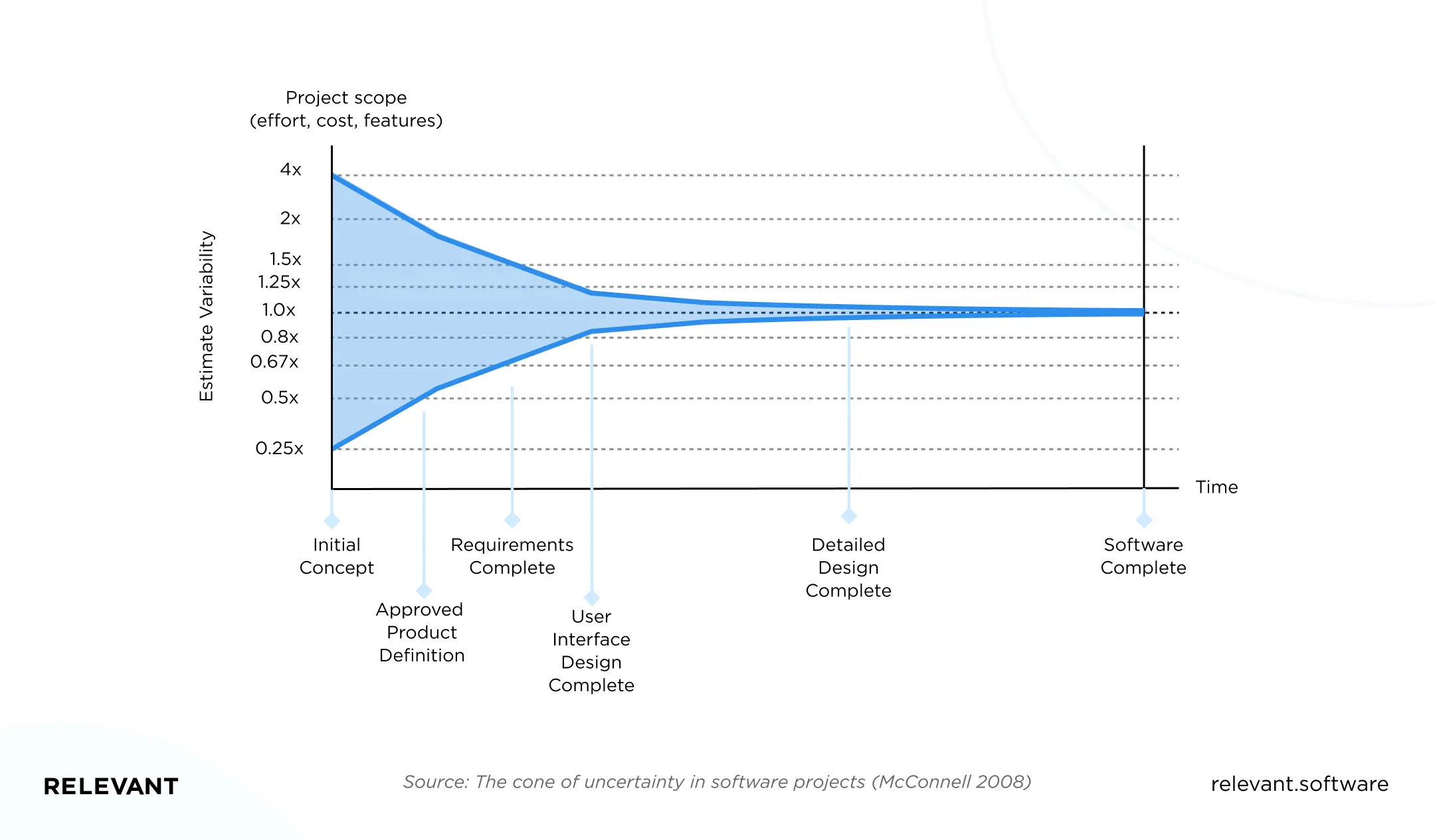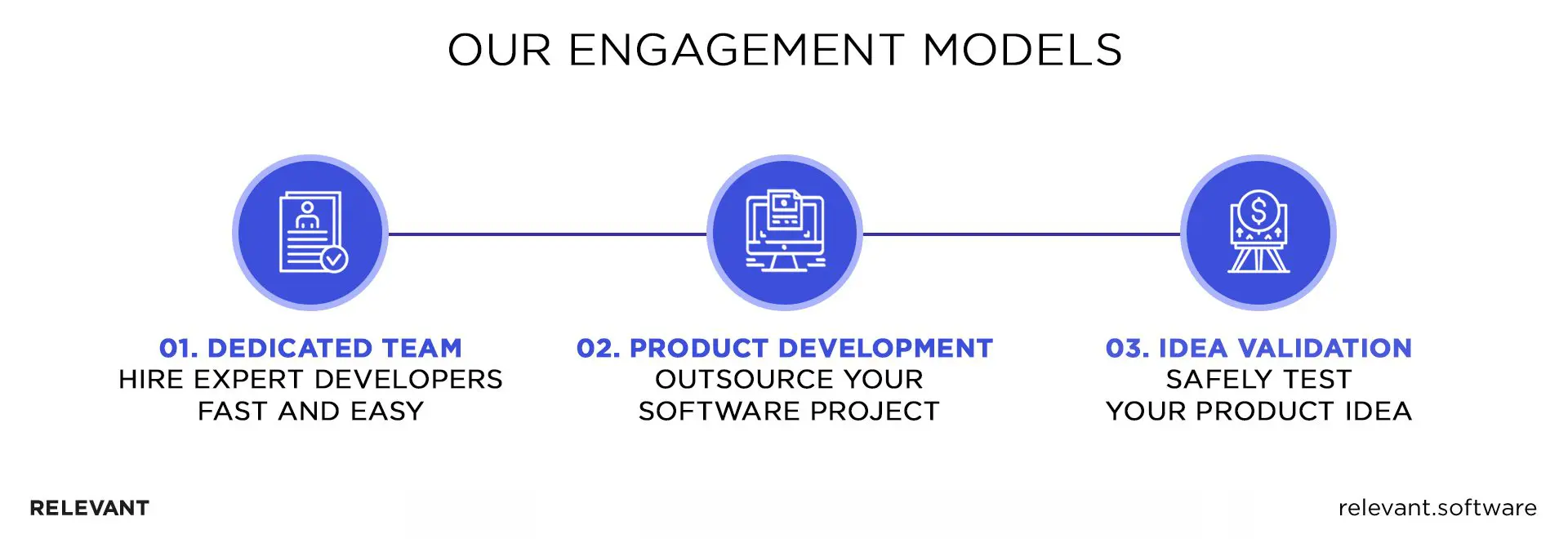Guidelines for Software Development Cost Estimation in 2023

“How much does it cost to develop a software application?” is one of the first questions a client asks the development team. But there is no immediate answer. You may need to build a one-feature product or an entire company’s internal system—and in both cases, the time and cost to implement your idea might be the same.
“How come?” you might wonder. Various factors affect the overall budget: from the complexity of a project, tech stack, and infrastructure to the level of expertise of your software vendor. So how to calculate software cost properly?
Having been in the software development field for 9+ years, we at Relevant have a clear idea of how much time and resources it might take to implement projects of various types. This article outlines guidelines for estimating costs in software engineering. We will shed light on influence factors, pricing model options, and the ins and outs of the estimation process. Keep reading to find out more.
Do you have a clear vision of your software?
Developing a software project is similar to building a house. If you have a detailed architectural plan, design mockup, and home decor vision, estimating the cost won’t be a problem. But if all you have is just an idea, an estimate you can get will be just a rough price range. So what should you do to get more specific numbers?
The Cone of Uncertainty, a concept described by Steve McConnell and Barry Boehm, perfectly illustrates how software estimation can stray from reality depending on the stage of development. In short, the more details you can provide, the more accurate an estimate you can expect.

A tricky question arises: how to estimate the budget for a software project when you are just at the outset? The answer is never to limit your product vision to a general concept description. The only way to get an accurate estimate is to specify the project by preparing correct project specifications, user flows, and UX/UI design.
However, those aren’t the only factors impacting the cost. Let’s look at the software development cost breakdown to understand better what’s in the price.
Factors that impact software development costs
The final budget is always crucial for any company creating a digital product. But there’s a catch: the software development process consists of many stages where every element can affect the software cost estimation. Here we put together a list of top factors determining the cost of software development in 2022.
Scope of work
Software development cost estimation will also vary depending on the following:
- The size of your project
- The complexity of its features
- The type of project (building from scratch or adding features to an existing solution)
These aspects will determine how many developers you need and how much time and effort it will take them to build your project. The table below shows the correlation between the project size, the scope of work, and the time required to complete it.
| Size of the project | Small | Medium | Large | Enterprise |
| Development time | Weeks | Weeks | Months | Months |
| Software modification | 1-2 | 2-6 | 2-6 | 4+ |
| Software development | 3-6 | 4-8 | 6-18 | 6+ |
| Software integration | 2-6 | 2-6 | 6-12 | 6+ |
| Building from scratch | 4-8 | 3-8 | 6-18 | 8+ |
[e-book id=”8445″]
Technology stack
The choice of technology directly influences the software development budget. A website, a native mobile app, or a cross-platform solution comes with a different price tag. Software developers’ rates also vary based on the technology they use. According to PayScale, hiring an Android or iOS developer is more expensive than, let’s say, a Unity expert. All these factors affect the software development budget.
When estimating a project, the development company will guide you on the required technologies and inform you whether they are open-source or come with a certain fee. On the plus side, modern programming languages offer many out-of-the-box tools and frameworks that speed up the process and cut development costs.
Infrastructure model
Another factor contributing to the final development costs is the infrastructure model: on-premise or cloud. On-premise infrastructure is located at the company’s site, which requires additional maintenance expenses, not to mention hardware costs.
Cloud infrastructure is usually a more cost-effective option. Most cloud providers offer flexible pricing plans depending on your load and needs. In our Guide to Modern Cloud-Based Application Development we highlighted the crucial elements of modern cloud-based application development to help you make the best innovation decisions.
UX/UI design
UX/UI design also contributes to the final price. The price tag depends on many factors, including hiring options (outsourcing design creation, working with a freelancer or in-house designer) and the overall design complexity. The price can vary greatly depending on whether you use ready-made templates, simple patterns, or a complex design with animations, custom illustrations, and transitions. The latter option can be quite costly and increase your final software development budget.
Development
Regarding development, a range of options can impact software cost estimation. Apart from the technologies, the final price will depend on the seniority of software developers and the team size. For instance, hiring more experienced senior developers will be costlier but can speed up the development and save time (and money). Depending on your project size, complexity, and deadline, you might need different structural roles in your team.
Management
You can manage the software development process on your side or let a vendor’s project manager do that for you—it all depends on how much you’d like to be involved in the project. The first option can save management costs, while the second keeps you from headaches.
When you outsource mobile app development for end-to-end services, it’s better to have a project manager guide the team’s work. But when hiring dedicated software development teams to boost your development capacity, management on your side might be your best bet.
Testing
Quality assurance is an essential part of developing stable bug-free software. Quality assurance and testing in 2022 take up to 22% of an overall project budget but can vary depending on:
- The complexity of your project
- Testing approach (automated or manual testing)
- Testing tools
It’s not recommended to scrimp on the testing budget, as it ensures the software product stability in the long run.
Security
Securing a software app is costly. Some security measures, for example, buying an SSL/TLS certificate to encrypt data in transit, come with a one-off fee. Others, like custom encryption, need a larger investment. Yet, these are the costs you must spend to ensure data protection. Check our blog post to get information on how to secure even the largest web application.
It isn’t a complete list of aspects impacting the software development budget. Some implicit ones could also affect the costs. Let’s take a closer look at them.
Future updates and maintenance
With the Agile approach, product development never stops; maintenance occurs simultaneously when customers start using your software product. This requires a sensitive budgeting balance for new features as they are requested while also funding for maintenance and support services (corrective, preventive, adaptive, or perfective) that you may need as a regular activity.
Other factors affecting the price
When it comes to software cost estimation, certain factors result directly from your decisions. Here’s a short rundown.
External integrations
Today, you can’t find a software product without any external integrations. The market offers many third-party tools that can boost your system’s capabilities, each of which has its price tag. On top of that, integration of third-party solutions requires additional time, which might also drive up the overall software development budget.
Yet, another side of the coin is that third-party integrations can lower software development costs. For instance, instead of building a secure payment system from scratch, it’s much easier to integrate one of the existing trustworthy third-party platforms. You’ll have to pay much lower, even in the long run, and will save your budget for other high-priority features.
Recruitment models
The software development market offers three basic recruitment models to choose from:
- Freelance developers
- Outsourcing development companies
- In-house teams
Each option has its pros and cons. From a budget perspective, the cheapest option is hiring a freelance developer. But it’s also the least reliable one. Hiring in-house developers involve additional costs like paid sick leaves, vacations, taxes, etc. Outsourcing here is the best choice in terms of money and services. Like in any other option, you might face some software outsourcing challenges. But you can easily solve them by choosing a reliable outsourcing partner.
Location
Your software project budget will also greatly depend on the development rates of the country you choose. According to PayScale, the most expensive software development services are in North America, Western Europe, and Australia. At the same time, Eastern European and Asian countries are considered the best countries to outsource software development to in terms of costs and quality.
Outsourcing to Ukraine is an excellent option if you want high-quality development services for a reasonable price. But what are the costs of software engineering in Ukraine? And how to calculate project cost software when you plan to hire Ukrainian developers?
| Region | Junior Developer | Middle Developer | Senior Developer |
| North America | $75-91 | $119-144 | $147-172 |
| South America | $41-53 | $53-66 | $65-82 |
| Western Europe | $50-70 | $70-90 | $100-149 |
| Eastern Europe | $35-53 | $47-65 | $68-76 |
| Asia | $25-36 | $35-41 | $41-49 |
| Australia | $70-85 | $85-100 | $115-140 |
How do we estimate software development cost at Relevant?
As a client, you should do a software development cost analysis before starting cooperation. It’s what people usually do when they buy something. But software development differs from purchasing ready-made products. Like any other intellectual activity, software development relies on the skills and expertise of developers.
So how to estimate a budget for a software project? At Relevant, we get these questions every day. We use a two-step framework that includes rough and detailed estimates. So let’s look at our company’s process and pricing models.
Rough estimation
It’s a first-stage estimation we provide when a potential client contacts us with a request to build a software product. The primary purpose of the rough estimate is to show preliminary budget boundaries and outline the possible development stages.
We need to understand your project vision to provide a rough estimate. Our specialists create a list of features for the product’s first version (MVP) and calculate the time required to implement them.
A rough project estimation proposes from 25% to 75% accuracy. It usually consists of two numbers indicating best and worst-case scenarios for each service, whether business analysis or front-end development. Here is an example of how it looks.

As a rule, it takes only a couple of days for us to give you a rough estimate.
Detailed estimation
Once we agree on the preliminary scope of work, we start preparing a detailed project estimation. That can be considered as a planning stage.
At that spell, our business analyst discusses everything with a client, gathers all the requirements, and turns them into specifications or a project plan. This document will inform designers and developers on your project’s technical and non-technical aspects, be it mandatory fields needed to log in or formulas used to calculate salaries.
In the end, you get a finalized specification document with a detailed time and cost breakdown. This step can take from a few days to two weeks. It all depends on the details you’re ready to provide and the size of your project.
Engagement models at Relevant
The best-fitting pricing model helps you to get the most out of your cooperation with a software development company. Depending on your requirements, we at Relevant can offer you three pricing models: hiring a dedicated team, outsourcing your product development to us, or safely testing your idea. Here is how they differ.

Dedicated team
Hiring a dedicated software development team is the best option if you want to quickly scale up your team and be in charge of the development process. It also allows you to avoid a lengthy hiring process and administration.
A dedicated development team is best suited for:
- Companies that want to extend their team capacity
- Businesses with tight deadlines
- Startups that need to scale fast
When choosing a dedicated development team model, Relevant gives you access to a pool of professionals that meet your requirements (level of seniority, skills, expertise, etc.). You can hand-pick candidates from this database. Once the team is formed, you manage them directly, communicating daily through audio and video tools. In general, all exactly like an in-house team, only in another office.
Product development
Software product development is your best option when you are just beginning and need tech expertise and a team to fulfill your project vision.
It’s better suited for:
- Early-stage startups without a tech team
- Businesses that launch their product
- Companies that want to digitize
We can offer full-cycle software product development services tailored to your needs—from market research and business analysis to design, development, deployment, and maintenance.
Idea validation
It is a perfect choice when your concept is still raw or you want to scale your business but aren’t sure how to make it. It’s best suited for:
- Fresh startups that want to test their product concept
- Companies that want to check how feasible their ideas are
- Entrepreneurs that would like to visualize how their future product will function
We can help you validate your idea, create prototypes, build an MVP, or conduct user testing at this stage. The choice of the pricing model depends on the goals you pursue, the scope of details you’re ready to provide, and the stage of your software project.
Final thoughts
The cost of software development depends on a range of factors. Some are quite obvious, while others come up only when you go deep into the software development process.
The estimation will be more accurate if you think through the details instead of just providing the dev company with a general concept. You can also reduce the risks if you validate your idea before building a full-fledged product.
Relevant has wide expertise in developing software products from the ground up and scaling the existing ones. So if you have a software product idea but don’t know where to start, contact us. Our team helps you with idea validation, market research, proof of concept, or developing your first product prototype.



